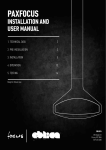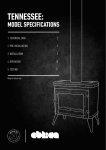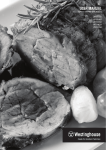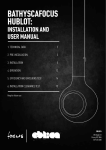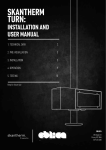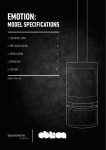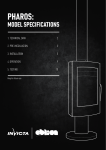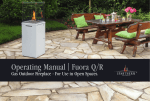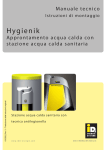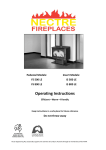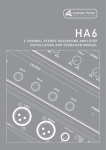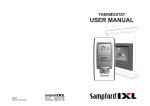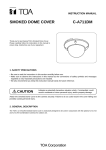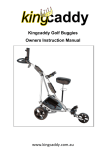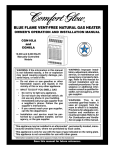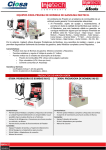Download Oblica Ergo Focus - Pivot Stove & Heating
Transcript
ErgoFocus: Installation and User Manual 1. Technical Data 2 2. PRE-Installation 3 3. INSTALLATION 5 4. Operation 11 5. TestING 13 Keep for future use Oblica 200 Argyle St Fitzroy VIC 3065 03 9416 0400 1. Technical Data Weight and dimensions: Firebox diameter Firebox weight Flue diameter Flue weight Standard bracket weight External flue kit 950mm 63Kg 219mm 16Kg/meter 20Kg Triple skin 200/250/300mm Determined under test conditions: Nominal thermal output Efficiency 5kW 46,1% FLUE ø219 mm FIREBOX ø950 mm 500 mm oblica | ERGOFOCUS Installation and User Manual page 2 2. Pre-INSTALLATION Congratulations on your purchase of the ErgoFocus. This appliance should be installed and checked by a qualified professional. Ensure you have read the operation guidelines thoroughly prior to first use. For any questions or concerns please contact Oblica on 03 9416 0400. The installation process is outlined below: – Determine position of firebox and flue carefully observing the clearances described within this section – Install the suspension bracket – Install the external flue – Install the internal flue and engage the firebox – Ensure the floor has adequate protection Caution: Using components or parts other than those provided by the manufacturer or modifying the specification of components may result in inferior or unsafe operation. If such action is necessary, consult the manufacturer in the first instance. Warning: • The appliance and flue-system must be installed in accordance with AS/NZS 2918 and the relevant building code or codes. • Any modification of the appliance that has not been approved in writing by the testing authority will be in breach of the approval granted for compliance with AS/NZS 4013. • Once the flue has been installed and approved by a professional installer, the flue must not be modified in any way. oblica | ERGOFOCUS Installation and User Manual page 3 MINIMUM CLEARANCE – INTERNAL 2.1 Clearance from non-combustible surfaces (eg masonry) 2.3 Clearance from combustible surfaces (eg timber joist & plasterboard) 100mm minimum clearance is required from fully non-combustible surfaces. 1200mm minimum clearance is required on all sides when the ErgoFocus can rotate 360˚ . Combustible 700 FIXED Combustible 500 s minium frame) Glass (frameless or aluminium frame) IMPORTANT: Frames must also be considered. Timber window frames must be treated as combustible surfaces 500(see 2.3). Aluminium frames can be treated as non-combustible surfaces (see 2.2). oblica | ERGOFOCUS Installation and User Manual FIXED 700 Combustible FULLY ROTATING 1200 700 500 Combustible Combustible 500 100 Non Combustible 500 Glass (frameless or aluminium frame) Glass (frameless or aluminium frame) 1200 Glass Glass (frameless or aluminium (frameless frame) or aluminium frame) 500 500 100 350mm minimum clearance is Combustible required from toughened glass. 700 FIXED 700 Combustible Non Combustible 700mm minimum rotation 1200 clearance is required if the FIXED FULLY ROTATING of the ErgoFocus is locked at 120˚ or 90˚ away from the wall. Locking the ErgoFocus so that the opening is fixed Glassclearance is Glass 500mm minimum required from normal (frameless or aluminium frame) (frameless or aluminium frame) is an option available on purchase. non-combustible glass. 100 2.2 Clearance from glass Combustib 700 1200 Combustible Combustible 1200 Combustible FULLY ROTATINGFULLY ROTATING 1200 100 Non Combustible Non Combustible Non Combustible 100 Combustible 1200 100 100 Combustible 1200 Non CombustibleNon Combustible 100 bustible 2. Pre-INSTALLATION (CONTINUED) Clearances may be reduced with the application of heat shielding to walls in accordance to the Australian Building Code. For information on heat shielding please contact our office on 03 9416 0400 or email info@oblica.com.au. page 4 700 3. InstallATION 3.1 Installing the suspension bracket • The bracket must be structurally secured within the roof as shown in the diagram below. • The largest cylinder must project down from the ceiling by at least 150mm (BCA requirement) unless the ceiling is made from a non-combustible material such as concrete. • You must leave a 25mm clearance gap between the bracket and the ceiling. This gap will be covered by the ceiling Flange. • 12mm ventilation gap between the plasterboard and the ceiling flange • 25mm minimum clearance from the triple skin flue to any combustible material within the roof space • 40mm minimum overlap of the stainless steel 8” flue into the connector Typical Flat ROOF INSTALLATION CHINAMAN HAT (Anti-Down-Draft device) TRIPLE SKIN FLUE 200 X 250 X 300 (8’ x 10’ x 12’) RUBBER FLASHING 250 Insulative pad 25 CROSS BAR SET IN-BETWEEN RAFTERS CEILING FLANGE 150 12 ( Plaster Ceiling Minimum Gap) 40 SUSPENSION BRACKET CONNECTOR LOWER FLUE 219mm dia. oblica | ERGOFOCUS Installation and User Manual page 5 3. InstallATION (CONTINUED) 12 oblica | ERGOFOCUS Installation and User Manual 150 25 Custom Length & Angle PITCHED ROOF INSTALLATION (Custom Made Bracket) page 6 3. InstallATION (CONTINUED) 3.2 Installing the external flue 1.Place the connection piece inside the suspension bracket. This will join the single skin flue below the bracket and the triple skin flue above the bracket which have different diameters. 2.Ensure the triple skin flue is installed as per Australian standards (see diagrams below). Pitched roof installation The top of the flue must be 400mm higher than the highest point of the roof. Alternatively, there must be a minimum distance of 8 meters from any higher section of roof. –> 40 cm –> 40 cm > –8m > 40 – cm –> 40 cm > –8m > 40 – cm –> 40 cm cm –> 120 Flat roof installation (less than 5˚ pitch) –> 120 cm > –8m > – 120 cm The top of the flue must be 1200mm above the roofline. Alternatively, there must be a minimum distance of 8 meters from any higher section of roof. –> 120 cm –> 120 cm oblica | ERGOFOCUS Installation and User Manual > –8m > – 120 cm page 7 3. InstallATION (CONTINUED) 3.3 Installing the internal flue 1.Position the single skin flue inside the suspension bracket and tighten the grab screws. Ensure that the flue is perfectly vertical and the grab screws are tight. Grab Screw 2.Engage the firebox with the bolt bearings as per the diagram below. Black steel single skin lower flue Thrust ball bearings Washers ø21/40 ep. 3mm Bearing holder ø13/27 M12 nuts Safety split pin oblica | ERGOFOCUS Installation and User Manual page 8 3. InstallATION (CONTINUED) 3.4 Protecting the floor •Any combustible floor beneath a fireplace must have a floor protector that extends 300mm beyond the diameter of the firebox in all directions. •If installed directly on combustible material, the floor protector must be made of a 20mm thick sheet of material with a thermal conductivity of 0.21W/m.K. Non-combustible finishes can be applied to the floor protector (tiles, steel sheet, light concrete, etc). • If the combustible floor is installed on concrete, you can replace the combustible material with noncombustible material laid directly onto the concrete. Floor protector laID on timber floor Combustible Combustible floor floor (eg. (eg. timber) timber) 300mm 300mm Insulative Insulative board board (20mm) (20mm) ++ non combustible non combustible finish finish Combustible Combustible floor floor(eg. (eg.timber) timber) 300mm 300mm Joist Joist Conc Con Floor protector laId on Joist FIR FIR Combustible Combustible floor (eg. timber) floor (eg. timber) 300mm 300mm Insulative board (20mm) Insulative board (20mm) + non combustible finish + non combustible finish Joist Joist oblica | ERGOFOCUS Installation and User Manual page 9 3. InstallATION (CONTINUED) Floor protector lAID on CONCRETE Combustible ) 300mm ombustible floor (eg. timber) h oor (eg. timber) 300mm Concrete Non combustible finish (eg.tiles) Non combustible finish (eg.tiles) Concrete TOP VIEW FIREBOX FIREBOX 300mm ) h 300mm Floor protector / Floor protectornon / combustible finish non combustible finish Combustible floor (eg. timber) Combustible floor (eg. timber) oblica | ERGOFOCUS Installation and User Manual page 10 4. OPERATION 4.1 What you should burn • Untreated, air dried hardwood •Split logs with a humidity content of less than 20% 4.2 Do not burn • Trash • Painted plastic • Coated or preservative treated wood • Waste or black coal •Inflammable liquids • Fire gels • Moist wood with a residual humidity content of more than 20% (this may cause soothing of the chimney). IMPORTANT: • Misuse may lead to unhealthy and environmentally harmful emissions and will void any warranty or guarantee. • The maximum load capacity for the ErgoFocus is 20kg of wood. • Burning only seasoned hardwood helps to protect the environment and lower emissions. For details of a wood supplier in your area please call our office on 03 9416 0400 or email info@oblica.com.au. Warning: • Do not use flammable liquids or aerosols to start or rekindle the fire. • Do not use flammable liquids or aerosols in the vicinity of the fireplace when operating. • Do not store fuel within prescribed installation clearance distances. • The use of some types of preservative-treated woods as a fuel can be hazardous. oblica | ERGOFOCUS Installation and User Manual page 11 5. Testing Test report Nº ATL17-10 Testing Laboratory: AHHA Testing Laboratory 6/26 Stirling st Thebarton, SA 5031 08 8351 8056 Manufacturer: Focus – Atelier Dominique Imbert Model:ErgoFocus open style fireplace Work requested: Measure CO2 levels as outlined in AS/NZS 4013:1999 to determine if appliance is excluded from full testing to this standard. Test Dates: 09/06/2010 Results: The maximum carbon dioxide output by the appliance during the high burn rate prescribed in AS/NZS 4013:1999 was 3.75%. Conclusion: This appliance meets the requirements of AS/NZS 4013:1999 section 1.2.3 (f) and is classified as an excluded appliance. oblica | ERGOFOCUS Installation and User Manual page 12












